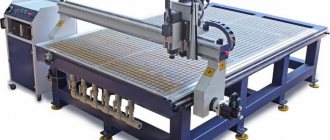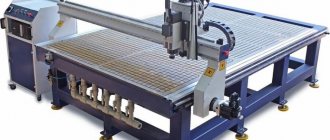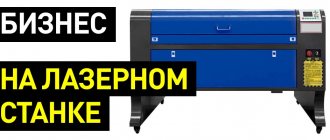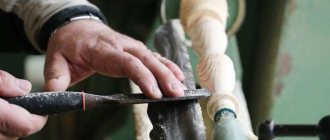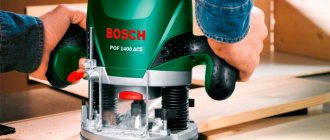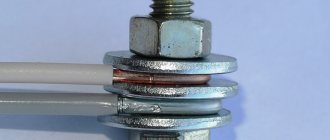Milling is the mechanical processing of wood, during which a CNC wood milling machine, or more precisely, a milling cutter (working tool), moving along 3 or more axes, cuts off a certain layer of material from the surface of the workpiece, which in turn can also move . Nowadays, the tool of milling machines can move in 3 directions: along the workpiece, across it and up and down relative to the work table, and on more advanced machines there are 4 or more axes that allow you to process the material from all sides without having to rearrange it on the table.
Nowadays, the tool of milling machines can move in 3 directions: along the workpiece, across it and up and down relative to the work table, and on more advanced machines there are 4 or more axes that allow you to process the material from all sides without having to rearrange it on the table.
Thanks to such movements, it becomes possible to process complex shapes and parts with high precision. Currently, various decorative items, facades, furniture panels, stairs, columns, balusters, interior elements, modeling, as well as souvenirs are mainly made from wood.
In almost any area in which a large number of similar products are produced, CNC wood milling machines are used due to a significant reduction in the cost of the process, improved quality and reduced time spent per unit of product.
Advantages
The main advantages of a machine controlled by a computer program are the accuracy and speed of woodworking, which make it possible to process both flat (2d) and three-dimensional (3d) parts, with elements of a wide variety of sizes and complexity. The process itself is fully automated, which completely eliminates the human factor from the milling process.
Also an undeniable advantage is visualization, which allows you to see the finished product on a computer monitor even before milling begins. Thanks to this, you can be completely confident that the final product will be exactly the product you saw on the screen.
Classification of machines
The equipment is quite complex, because in addition to mechanical components, it contains an electronic unit, and it is not recommended to repair it without a specialist. You can divide machines according to qualifying indicators.
Level of versatility
- Special. Designed for narrow-profile work. For example, for cutting out icons, statues, frames, etc.
- Specialized. Such 3D machines are also considered highly targeted; they can perform their functions with different but similar parts.
- Universal. Used for the manufacture of any parts.
Degree of accuracy
- Normal machines - “N”. Most often used in workshops because the process does not require precision.
- Increased accuracy - “P”. A highly specialized machine, one might say, for creating real masterpieces.
Chip formation and how to deal with it
CNC milling of wood is carried out in several passes. The first few passes are roughing, during which the tool cuts off a lot of material, leaving only the outlines of the future product. This is followed by a finishing pass, during which the product acquires its finished appearance and the necessary surface cleanliness. Finishing is usually done with a fine-toothed cone or cylindrical cutter, rotating at high speed and using a large number of passes in succession.
During operation, the cutter often needs to cut into the material to a great depth. To prevent the cutter from becoming clogged with chips and not overheating, you need to provide it with normal cutting conditions, for this you need to take into account the hardness of the wood, the immersion speed, and not cut to a great depth at one time. It is better to do this in several approaches.
Since the process of processing a wooden workpiece produces a lot of chips, dust and other waste, it is necessary to install a device on the CNC wood router that will remove the chips directly from the cutting site. It works on the principle of a vacuum cleaner and is installed on the Z axis, as close as possible to the working tool.
Thanks to the dust collection system, you can permanently extend the service life of guides, lead screws, bearings, as well as motors, which are also very sensitive to various types of contamination, like all CNC woodworking machines and those without numerical control.
Accessories
The set of components for CNC equipment directly depends on its type. However, there are details common to the fundamental design of such machines:
- Bed - depending on the overall dimensions of the equipment, it can be either floor-mounted or table-top;
- A portal is a set of guides along which the working part moves in a two- or three-dimensional coordinate axis;
- Power units are servos that drive the portal, as well as an electric motor that transmits rotational motion to the spindle;
- Various mechanical parts: rail guides, shafts, bearings, couplings, etc.;
- Control controller - a communication board on which the program is recorded, and sensors that control the operation of the device;
- Power supplies.
Softwood processing
When processing soft wood, you need to remember some subtleties
- The program itself, which is responsible for processing, becomes much more complicated. This is primarily necessary to accurately track the position of the cutting tool throughout the entire machining process. The milling speed must be set as low as possible to achieve the highest quality of the finished surface. This is accompanied by a large disadvantage in relation to the quantity of output.
- Since the tool cannot be ideal from the point of view of geometry, it inevitably has, albeit minimal, backlash, which excludes the possibility of obtaining smooth edges (as with hand carving). Also, milling soft wood is accompanied by the appearance of fine pile on the surface, which is subsequently very difficult to sand off (CNC milling machines are usually not equipped with this function), especially in hard-to-reach places (such as sharp recesses). And if you accidentally touch a lint and start pulling on it, there is a chance that several fibers will be torn off from the wood, which will ruin the entire product, and you will have to repeat the long and labor-intensive woodworking process all over again.
But, even despite these difficulties, high-quality processing of complex three-dimensional parts is quite possible. First of all, you need to be able to use computer programs such as ArtCam. Thanks to them, you can preview the difficult spots that will appear during processing, assign the necessary tool for each section of the workpiece, and calculate the approximate time spent on complete processing.
Instructions for beginner CNC machine operators – “SPRUT-Technology”
This is called parametric modeling.
To get acquainted with such programs, follow the links: Inventor SolidWorks OnShape Compass 3D Creo
Recommended programs (CAD systems): when choosing a program, you should think not only about simplicity, but also about prospects and functionality. For designers without experience, I recommend drawing 3D models in the Tinkercad web application. Tinkercad works in browsers that support 3D functionality: Chrome, Firefox, Yandex.
Stage II - explain to the machine how to process the workpiece to produce a part
After receiving the model, you need to explain to the machine how (at what speed, what tool, and most importantly, along what trajectory) to process the workpiece to obtain the planned part. All this is called a technological process. To write the technical process, CAM systems are used or, as it is called, a CNC program.
To write a technical process, I recommend that you use the SprutCAM program. This is a full-featured professional CAM system from a domestic developer, indispensable for programming CNC machines for beginners
For small productions there is a special offer available - SprutCAM Practik. These are programs for CNC machines in Russian running Mach3, NCStudio, LinuxCNC and analogues. The SprutCAM Practik installer can be downloaded for free.
- The task is to explain to the machine how to process the part
- The solution is to write a technical process in a CAM system
In the CAM system, the trajectory of the tool is determined, then this information is translated into a specialized G code language (in the figure), which the CNC machine itself understands.
Wood finishing
After rough processing, the milling cutter of the unit is replaced with a smaller one (most often conical or spherical), which can perform finishing milling to achieve the required quality of the finished surface.
The finishing speed is very slow, causing the overall productivity to drop significantly. Also, the time spent on changing tools during finishing is very strongly influenced, since milling is usually carried out with several cutters.
The cost of the finished product also increases significantly, since it most often depends on the operating time of a CNC wood router and the labor costs for developing a processing program.
Milling equipment - technological capabilities
- turning work - using additional tools, you can trim the surface of workpieces, apply threads, work with cylindrical, conical and other shapes, drill and countersink holes;
- engraving operations – modern milling equipment allows for high-precision engraving work, regardless of the complexity of the pattern and the fragility of the material;
- work on cutting, cutting and shaped cutting of wood materials, stone and metals;
- creation of three-dimensional products using 3D programs.
Wood engraving
Engraving is the milling of various inscriptions, drawings, patterns onto a wooden or other surface that can be processed.
Engraving of inscriptions
Basically, engraving is done using a high-quality spherical cutter, which must be securely mounted in a wood milling machine (to reduce vibrations and improve the quality of the original surface) or using special engravers. Engravers come in U and V types. U type engravers are designed for milling text, and V type are designed for milling special 3D images, which is produced with a V shaped cutter.
After finishing, the surface of hardwood is smooth, has a pleasant shine and does not require further processing or polishing.
Why do you need a 3D CNC wood milling machine?
Handmade products are always expensive. Hand carving is a rather lengthy and difficult process. Of course, after using the machine, some work may be needed, but it will be minor and will not take a lot of time.
Now various interior elements are available to everyone, because machine-made products are much cheaper than hand-made ones.
What can be made with a 3D milling machine:
- Furniture parts (handrails, legs of cabinets/chairs/sofas, upholstery, etc.).
- Elements of a fence, stairs, roof, gazebo.
- Framework.
- Frames.
- Statues and icons, etc.
How to choose the type of wood for subsequent processing
A lot depends on the material, from the wear of the cutting tool to the quality of the finished product. Let's take a closer look at what you need to pay attention to first:
- The best hardwoods to process are beech and ash. If you use oak, the quality of the surface will increase significantly, but the main disadvantage is that dry oak can unexpectedly chip, ruining the entire product.
- The moisture content of the wood is also very important; it should be as low as possible (no more than 8 percent). If it is high, then there is a possibility that the finished product will soon “lead” and it will change its shape.
- It is advisable to take a tree of the first and second grades, which has a minimum number of knots, fallow and various damage by parasites;
- The cutting depth must be selected individually for each material in order to prevent the workpiece from burning or chipping on its surface.
Description of design
There are many types of CNC milling machines for working with wood. They are different from each other, but similar in structure.
The main parts are the bed, supports, milling table, spindle, cutting tool. Some devices have additional equipment, the main part of which is the carriage. It allows you to work from different angles.
Details Description:
- Milling table - the basis of the structure, working area
- Calipers - used to secure working tools.
- Bed – holds together the structural parts.
- Spindle is a device that secures the workpiece during operation. Rotates the workpiece during operation. The higher the rotation speed, the higher the quality of the products.
- Cutting tool - used to process material.
Cutting tools are different in each type of equipment. Mainly used are knives, discs, cutters and drills.
One more detail: if you are purchasing a unit for high-precision machining, then pay attention to the spindle. Rotation speed directly affects processing accuracy.
Another advantage of CNC milling machines is safety. The tools have a safe structure and location.
Safety precautions when working with a CNC router
When working with technical equipment, adhere to certain rules. This is not only related to operational efficiency, but also to safety.
Working with technical equipment is dangerous, and following safety precautions reduces the risk of harm to health.
Safety rules:
- Start work only in special uniform. The CNC machine operator will need to touch sharp objects. Touching with bare hands increases the risk of puncture and cutting wounds.
- The working space should be 2 times larger than the size of the machine. This is necessary to distance yourself from the workplace in critical situations.
- Fire resistance of walls, floors and ceilings. Reduces the risk of fire.
- The floor must be level. Required to securely secure the device.
- Availability of good lighting.
Room
organize a mini carpentry workshop in your garage or a separate room in the local area if you live outside the city or have a dacha. In the absence of such an opportunity, suitable premises can be rented.
Required area: 20-40 square meters . The room must meet fire safety requirements, be heated and have forced ventilation. When expanding production, additional space will be needed for storage and drying of products.
